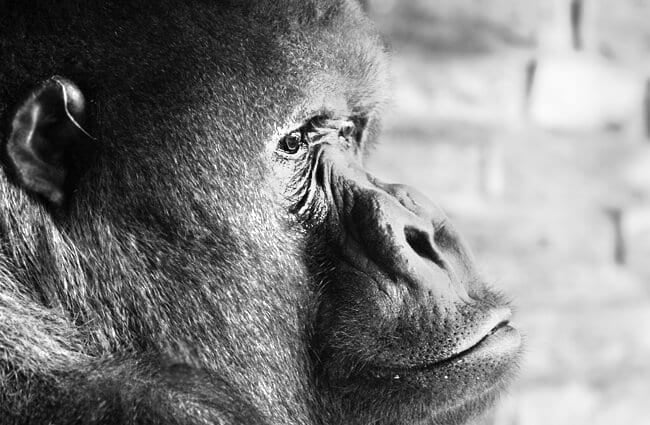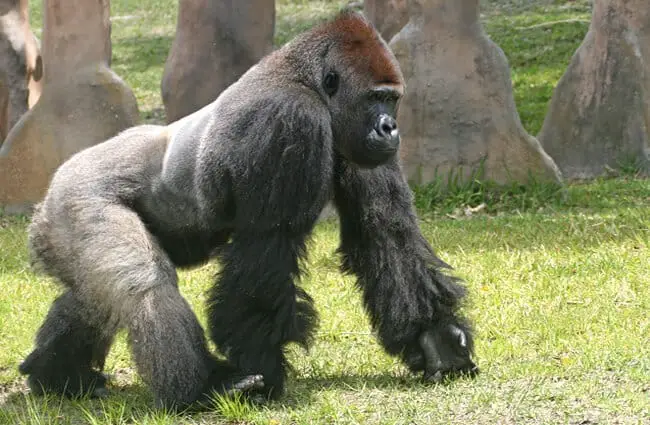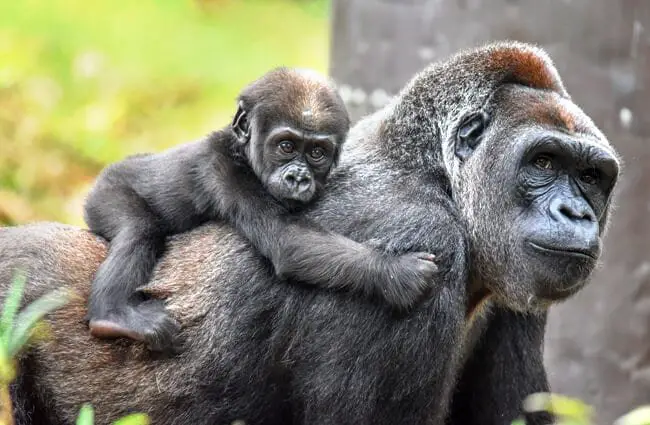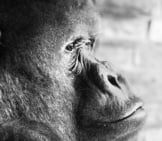Gorillas are large apes that live in the jungles of Africa. There are two species of gorillas, western gorillas and eastern gorillas. They are the largest of the great apes, and they are largest primates alive today. The IUCN lists both the Western Gorilla and the Eastern Gorilla species as Critically Endangered. Poaching and habitat loss are the primary dangers to gorillas. Read on to learn about the gorilla.
Description of the Gorilla
Gorillas are quite large, and adult males can measure nearly 6 ft. tall. Their armspan is an impressive 7 – 8 ft. across. Males weigh between 300 and 430 lbs., while females weigh between 150 and 250 lbs.
They have thick black fur across their bodies, save for their faces, the palms of their hands, and the bottoms of their feet. The subspecies that live in mountainous regions have even thicker fur than their counterparts.
Interesting Facts About the Gorilla
These intelligent apes have intrigued us for centuries. Sadly, warfare within the countries in which these apes live is directly impacting them. Learn more about what makes these unique creatures worth protecting below.
- Locomotion – While gorillas can move about on their hind legs when necessary, they usually travel by knuckle-walking. They close their fists, and place their hands knuckle-down on the ground to walk on all fours. Chimpanzees also knuckle-walk, but they walk on their rear legs more frequently than do gorillas. Oddly enough, anteaters also walk on their knuckles!
- Silverback – Adult male gorillas develop silver-grey hair on their backs. Because of this trait, many people call them “silverbacks.” This coloration runs from the back to the hips of adult males.
- One of a Kind – If a gorilla committed a crime, we could discover who did it by using some of the same techniques that we use for humans! This is because gorillas not only have fingerprints, but every fingerprint is different, just like in humans. However, gorillas are generally peaceful when left alone, and tend to avoid a life of crime.
- Nesting – Just like orangutans, gorillas build nests. Unlike orangutans, gorillas usually sleep in nests on the ground instead of in the trees. The nests are around two feet and five feet across, and each gorilla builds its own nest. Once baby gorillas reach three years of age, they build their own nests close to their mothers.
Habitat of the Gorilla
Different species and subspecies of gorillas prefer different habitats. Some species or subspecies live in dense forests, others in swamps. Many species live in mountainous regions, and some even live up to 13,000 ft. above sea level.
Some of their preferred habitats are bamboo forests, lowland swamps, mountain forests, lowland forests, and more. Though they live in forests, and can climb well, gorillas spend much of their time on the ground.
Distribution of the Gorilla
The different species and subspecies of gorillas have different ranges. The Congo River splits two species. The western gorilla lives in the forests of western Africa, and is more widespread than the eastern gorilla.
Western gorillas live primarily in Gabon, Equatorial Guinea, Congo, and Cameroon. Eastern gorillas live in a small range in the eastern Democratic Republic of Congo.
Diet of the Gorilla
Gorillas are primarily herbivores, which means that they eat plants. The vast majority of their diet contains leaves, shoots, stems, and other plant parts. They do eat fruit, but it does not make up a large portion of their diet.
The exact plants eaten vary by season, species, and region. Outside plants, gorillas also occasionally eat ants, termites, and some other insects. The plants they eat contain lots of moisture, so they rarely drink water.
Remembering Koko the Gorilla
Early in the morning on June 19, 2018, Koko the gorilla passed away peacefully in her sleep at the age of 46. Koko was a groundbreaking gorilla, and she participated in hundreds of behavioral studies. She helped scientists understand so much more about gorilla intelligence and behavior than they had before.
Koko understood American Sign Language, and knew over 1,000 different signs. She used sign language to communicate with her handlers in ways more complex than anyone could have imagined. She even had a number of kittens as pets, which she named herself, and she met numerous celebrities.
Gorilla and Human Interaction
Human activity heavily impacts all species and subspecies of gorillas. The IUCN lists both species as Critically Endangered because of human impact. War in the area increases the amount of weapons available to poachers, and the demand for bushmeat increases because the war drains resources. Poaching is the primary cause of decline, followed by habitat destruction.
There are a number of different conservation projects for gorillas, as well as captive breeding programs in zoos. Some conservation projects include the Great Apes Survival Partnership, the Agreement on the Conservation of Gorillas and Their Habitats, and more.
Domestication
Humans have not domesticated gorillas in any way.
Does the Gorilla Make a Good Pet
No, gorillas do not make good pets. They are large apes, and would definitely not fit in your home or apartment as a house pet! Furthermore, gorillas are critically endangered, and every individual is important for the survival of the species. It is illegal to harm or molest them in any way.
Gorilla Care
Zoos selectively breed gorillas for the most diverse genetics. A species survival program keeps a record of all the animals in zoos, and selects the best pairs to keep future generations healthy. Gorilla habitats have a variety of hiding places, climbing opportunities, and other physical structures.
In addition to permanent structures in the enclosure, zookeepers provide the gorillas with a variety of environmental enrichment like toys, puzzles, hidden food, positive reinforcement training, and more. Some zoos even have iPads for their gorillas to use!
Behavior of the Gorilla
These apes live in groups called “troops.” Most troops have a single adult male, several females, and their offspring. As the males reach adulthood, they set off to create troops of their own, but some males remain in their family group for longer periods.
These males remain subordinate, and their father is the dominant male who can mate with the females. Subordinate males do not have the characteristic silver hair that dominant males do. The troops spend half their time searching for food, and half their time traveling to new areas.
Reproduction of the Gorilla
Female gorillas reproduce for the first time when they are 10 – 12 years old. After mating, the female’s gestation period is 8.5 months long. The interval between babies is usually around 4 years. The females care for the babies on their own, but the males interact and socialize with the babies.
The babies are in constant contact with their mothers for the first 5 months of life, and do not venture far from her until they are a year old. They remain closely associated with their mothers until they are around 3 years old, but slowly spend more time on their own.













![Red Angus Closeup of a beautiful Red Angus cowPhoto by: U.S. Department of Agriculture [pubic domain]https://creativecommons.org/licenses/by/2.0/](https://animals.net/wp-content/uploads/2020/03/Red-Angus-4-238x178.jpg)












![Red Angus Closeup of a beautiful Red Angus cowPhoto by: U.S. Department of Agriculture [pubic domain]https://creativecommons.org/licenses/by/2.0/](https://animals.net/wp-content/uploads/2020/03/Red-Angus-4-100x75.jpg)

